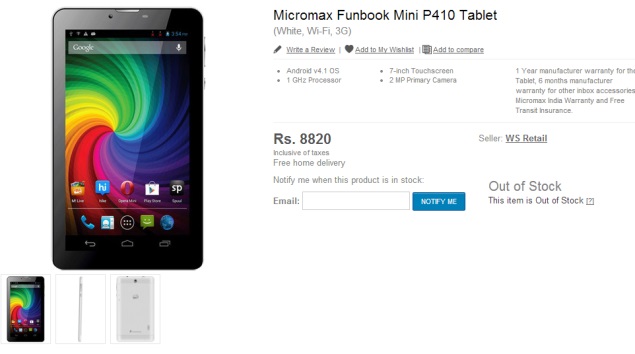Micromax is pushing into the low-cost tablet market with devices costing less than Rs. 10,000 in India. Following the strategy the domestic handset maker's new budget Android tablet, the Funbook Mini tablet has been listed on ecommerce website, Flipkart for Rs. 8,820. However, the device is right now out of stock at the online retailer and comes with a 'notify me' option.

The Micromax Funbook Mini P410 tablet comes with 7-inch LCD display with 1024x600 pixels resolution. The Android 4.1 Jelly Bean-based tablet supports dual-SIM (GSM+GSM). It is powered by a 1GHz dual-core processor along with 1GB of RAM. It includes 4GB of inbuilt storage which can be expandable up to 32GB via microSD card. The tablet sports a 2-megapixel rear camera while there is a 0.3-megapixel front-facing camera. There is a 2800mAh battery which can deliver up to 4 hours of browsing time, mentions the listing. The Micromax Funbook Mini tablet will be available in White.
Recently, Micromax introduced its first flagship tablet in the Canvas series, calling it the Canvas Tab P650. The Canvas Tab P650 has been launched at Rs. 16,500 for the Indian market, and comes with 8-inch IPS display (resolution unspecified), whilst being powered by a 1.2GHz quad-core processor coupled with 1GB of RAM. It comes with 16GB of inbuilt storage that is further expandable up to 32GB via microSD card.

The Canvas Tab P650 runs Android 4.2.1 Jelly Bean and is upgradable via FOTA (firmware over the air). The tablet sports a 5-megapixel autofocus rear camera while there is also a 2-megapixel front-facing camera onboard. The Canvas Tab P650 comes with SIM support and has voice-calling, however, the company has not detailed if the device supports single SIM or is dual-SIM.
Micromax Funbook Mini tablet key specifications
- 7-inch LCD display with 1024x600 pixels resolution
- 1GHz dual-core processor
- 1GB of RAM
- 4GB of built-in storage, expandable up to 32GB
- 2-megapixel rear camera
- 0.3-megapixel front-facing camera
- Android 4.1 Jelly Bean
- 2800 mAh battery
- Dual-SIM (GSM+GSM)
 New Delhi: Samsung India on Sunday said it will soon start manufacturing its flagship high-end smartphone Galaxy S4 in India.
New Delhi: Samsung India on Sunday said it will soon start manufacturing its flagship high-end smartphone Galaxy S4 in India.
